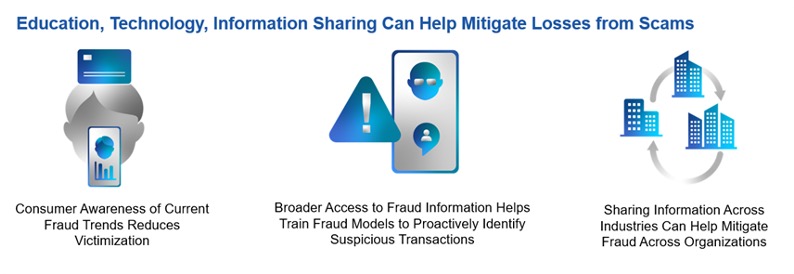Scams, Swindles – and Solutions
There is real money in perpetuating scams. The Federal Trade Commission (Off-site) reported more than $10 billion in losses from scam activity in 2023, a 14% increase from the previous year. This number shows how lucrative it can be for fraudsters to swindle businesses and individuals alike.
Phishing (Off-site) is one common “social engineering” fraud tactic. The fraudster uses emails, text messages or phone calls to trick the recipient into believing an urgent request or inquiry is from a legitimate business. The goal: convince the victim to transfer money or enable the fraudster to gain funds using sensitive personal information, such as login credentials, account numbers and credit card information. Fraudulent emails and texts also can convince victims to click into a link that downloads malicious software – commonly known as malware (Off-site) – which is specifically designed to disrupt, damage or gain unauthorized access to a business or individual’s computer system.

In 2023, the Federal Reserve engaged with payments and fraud experts to develop and publish an operational definition of scams: the use of deception or manipulation intended to achieve financial gain. In 2024, the Fed-led scams definition and classification industry work group developed the ScamClassifierSM model, a voluntary scam classification structure to help the industry categorize different scam types more consistently by using this agreed-upon definition as a basis.
Also in 2024, a scams information sharing industry work group recommended that the industry consider creating a solution or establishing an independent information exchange framework to provide a holistic view of scam intelligence from existing sources across payment rails. The published report included ideas on how an exchange could be established and evolve, while acknowledging that identifying or building a solution with the full functionality envisioned by the industry work group will take time. An information exchange could connect existing and future information sources; allow organizations to gain a comprehensive view of emerging scam threats, patterns and tactics; and enable better analysis and more effective preventative measures.

These two work groups are just the beginning of building industrywide consensus about practical solutions to the growing and costly problem of scams. Stay informed about the Fed’s efforts to support payment security and mitigate fraud by joining the FedPayments Improvement Community.
